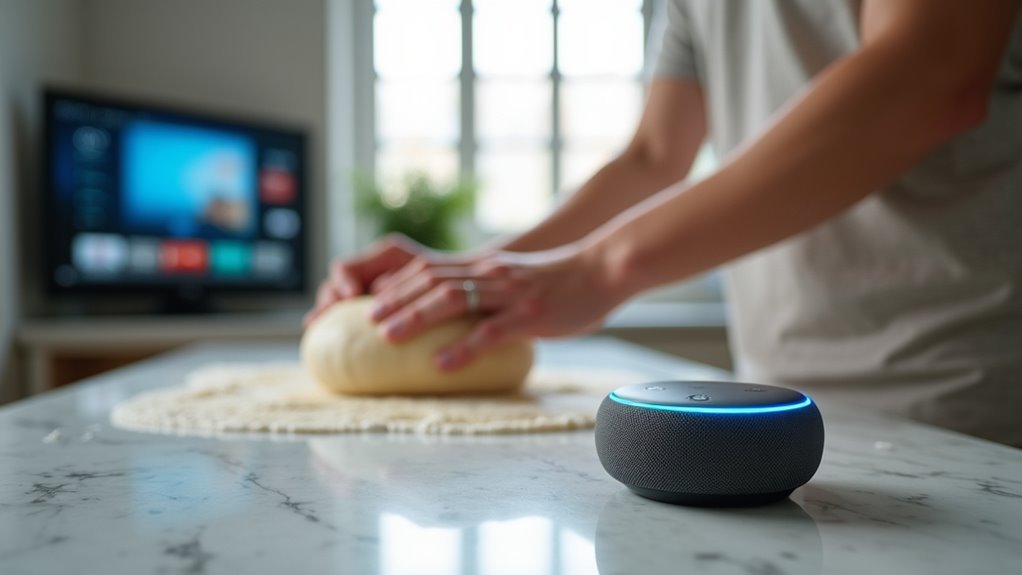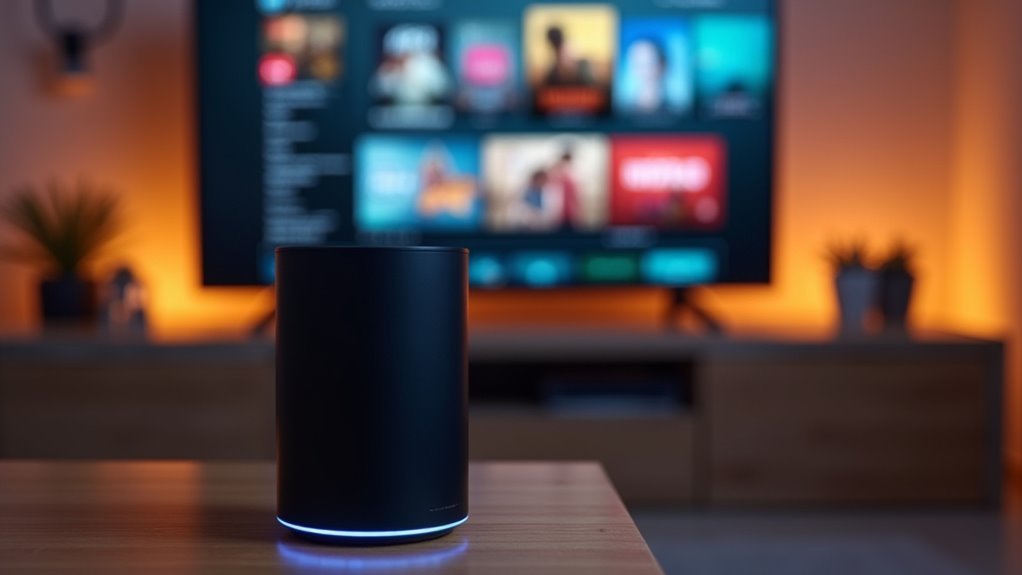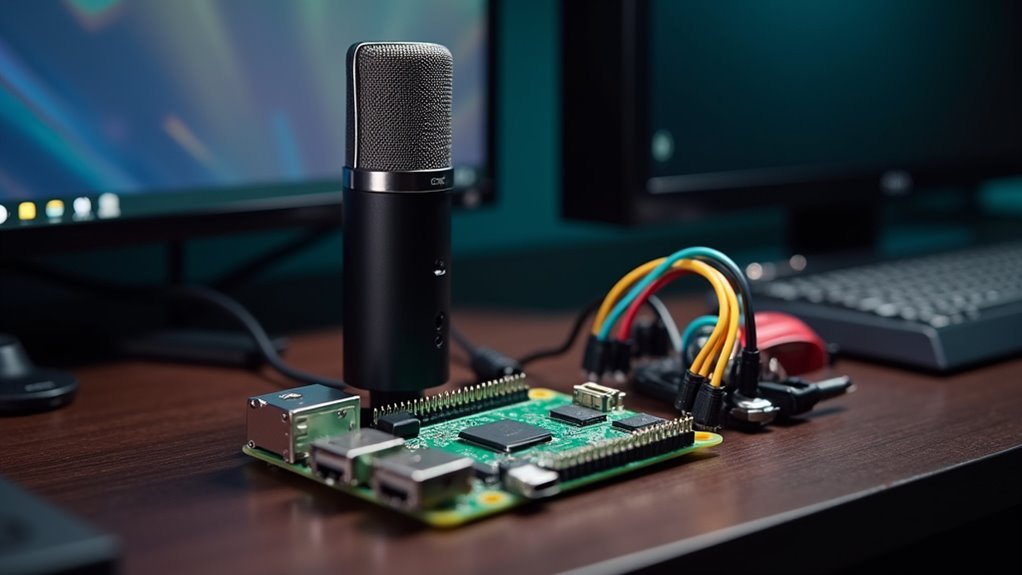You’re probably tired of fumbling for your remote every time you want to pause a show or search for something new to watch. Voice commands have quietly revolutionized how you interact with streaming platforms, turning your simple spoken words into powerful navigation tools. But there’s more happening behind the scenes than just convenience – the technology is reshaping accessibility, privacy, and even how content finds its way to you.
The Technology Behind Voice Recognition in Streaming Devices

When you speak to your streaming device, sophisticated algorithms and natural language processing work instantly to decode your words and transform them into precise commands. Voice recognition technology analyzes your speech patterns, breaks down audio signals into digital data, and matches them against vast databases of voice samples. This process happens within milliseconds, enabling real-time responses to your requests.
Smart TVs integrate these advanced systems to recognize activation phrases like “Hey Google” or “Ok Google,” triggering immediate device responsiveness.
Smart TVs seamlessly integrate voice recognition technology, instantly responding to activation phrases and transforming spoken commands into immediate device actions.
The technology continuously learns from your interactions, improving accuracy over time. Machine learning algorithms adapt to your accent, speaking speed, and vocabulary preferences, creating a personalized experience.
This sophisticated backend processing guarantees that when you ask for a specific show or adjust volume settings, your device responds with remarkable precision and speed.
Enhanced Accessibility for Users With Disabilities
Beyond mere convenience, voice commands transform streaming into an accessible gateway for users with disabilities.
You’ll discover that enhancing user experience through voice technology creates unprecedented independence for those facing visual impairments or motor challenges.
Smart home devices equipped with voice recognition deliver transformative benefits:
- Hands-free navigation – You can control streaming services without traditional remotes or screen interaction.
- Simplified content discovery – Voice searches eliminate complex manual inputs for finding shows and movies.
- Multitasking capabilities – You’re able to manage entertainment while handling other essential tasks simultaneously.
- Inclusive design – Over 55% of voice-assisted households now support barrier-free streaming access.
This technology guarantees you’re not excluded from digital entertainment, creating equitable experiences that meet diverse accessibility needs through intuitive voice-based interaction.
Hands-Free Control During Multitasking Activities

You’ll find voice commands transform your streaming experience when you’re juggling multiple activities throughout your day.
Whether you’re chopping vegetables in the kitchen, breaking a sweat during your workout, or tackling household cleaning tasks, voice control lets you manage your entertainment without missing a beat.
This hands-free approach means you can seamlessly adjust volume, skip tracks, or switch content while keeping your hands busy with whatever task demands your attention.
Cooking While Streaming
While you’re chopping vegetables or stirring a simmering sauce, voice commands transform your kitchen into a seamlessly connected streaming hub.
With over 70% of audio listeners utilizing smart speakers, you can effortlessly navigate content without interrupting your culinary workflow.
Voice control revolutionizes your streaming experience with voice technology by eliminating manual input entirely.
Here’s how voice commands enhance your cooking sessions:
- Recipe searches – Find cooking shows and tutorials instantly while your hands stay busy
- Playback adjustments – Control volume and skip content without touching devices
- Content switching – Change shows or playlists seamlessly during meal preparation
- Music requests – Create immersive cooking environments with specific audio content
With 60% of users favoring voice commands for audio access, you’ll discover improved satisfaction through simplified multitasking capabilities.
Exercise and Entertainment
When you’re powering through a challenging workout, voice commands become your essential streaming companion, letting you control content without breaking stride or compromising your form. You can seamlessly pause, skip tracks, or adjust volume without touching your device, maintaining perfect workout flow.
With over 70% of audio listeners using smart speakers, accessing your favorite playlists or discovering new music becomes effortless during physical activities.
Voice recognition AI transforms how you navigate streaming services while exercising. More than 60% of users prefer hands-free interaction, especially when manual controls aren’t practical.
Whether you’re lifting weights, running on a treadmill, or doing yoga, you’ll appreciate how voice commands eliminate interruptions. This technology enhances your streaming experience, allowing you to stay focused on your fitness goals while enjoying seamless entertainment control.
Household Chores Integration
Voice commands revolutionize how you manage streaming content during household chores, transforming mundane tasks into entertainment-rich experiences.
You’ll discover that hands-free control eliminates the constant interruption of stopping to manually adjust your device while cleaning, cooking, or organizing.
Over 60% of audio listeners prefer voice commands for content access, and nearly 40% favor hands-free interaction for daily tasks.
Here’s how voice commands enhance your household routine:
- Effortless content control – Pause, play, or skip without touching devices
- Seamless multitasking – Continue chores while managing entertainment
- Quick library access – Navigate streaming platforms without manual interaction
- Enhanced productivity – Maintain workflow while staying entertained
This integration boosts user satisfaction by making streaming platforms truly accessible during your busiest moments.
Smart Speaker Integration With Popular Streaming Platforms

Since over 70% of households now own at least one smart speaker, these devices have transformed how you interact with your favorite streaming platforms. Smart speaker integration allows you to control your music, podcasts, and audio content using simple voice commands, creating a seamless listening experience.
You’ll find that nearly 60% of users report voice commands greatly improve their streaming interactions. Instead of manually searching through apps, you can simply ask your device to play specific artists, create playlists, or discover new content. Over 50% of audio listeners now rely on voice commands for content access.
This hands-free control means you can manage playback while cooking, exercising, or relaxing.
With projections showing over 1 billion voice-activated devices by 2025, this intuitive technology continues reshaping how you consume streaming content.
Personalized Content Recommendations Through Voice Commands
Beyond basic playback control, your smart speaker’s AI analyzes your listening patterns and viewing history to deliver increasingly accurate content recommendations.
Voice commands transform how you discover new shows and movies by making personalized recommendations instantly accessible.
Through voice activation, finding your next favorite show becomes as simple as speaking your preferences aloud.
This technology delivers significant advantages:
- Tailored suggestions based on your individual viewing preferences and behavior patterns
- Improved satisfaction with over 50% of users reporting enhanced streaming experiences
- Seamless exploration of broader content ranges through simple voice navigation
- Enhanced engagement that promotes retention as you’re more likely to explore aligned content
As natural language processing evolves, your voice-activated recommendations will become even more precise.
You’ll effortlessly discover content that matches your interests, making your streaming experience more enjoyable and personalized than ever before.
Eliminating Physical Remote Dependencies
When you use voice commands for streaming, you’ll immediately notice how liberating it feels to control your device without reaching for a remote.
You can change channels, search for shows, and adjust volume simply by speaking, eliminating the frustration of slow cursor movement and endless clicking.
This hands-free approach transforms your viewing experience from a physical interaction with buttons to an effortless conversation with your entertainment system.
Hands-Free Device Control
Voice commands transform your streaming experience by freeing you from the constant need to locate, grab, and navigate with physical remotes.
You’ll discover unprecedented convenience as voice technology eliminates typing frustrations and streamlines content access.
Smart speakers have revolutionized how you interact with entertainment systems, with 70% of audio listeners embracing this hands-free approach.
Here’s what voice control delivers:
- Instant channel switching without searching for remotes
- Effortless volume adjustments through simple verbal commands
- Quick content searches that bypass clunky remote typing
- Accessible control for users with mobility limitations
With 93% satisfaction rates among voice command users, you’re joining millions who’ve discovered this seamless interaction method.
Over 62% of Americans regularly use voice control, proving this technology’s transformative impact on modern streaming habits.
Remote-Free Navigation Benefits
Physical remotes disappear from your daily streaming routine when you embrace voice-powered guidance systems. You’ll eliminate the frustration of searching for misplaced remote controls while gaining instant access to your favorite content.
| Traditional Remote Method | Voice Command Alternative |
|---|---|
| Typing search terms with buttons | Speaking titles naturally |
| Guiding through complex menu systems | Direct content requests |
| Adjusting volume manually | Voice-controlled audio levels |
| Channel surfing with clicks | Instant channel switching |
Using voice commands transforms your viewing experience by removing physical barriers between you and entertainment. You’re among 62% of Americans who regularly use voice control, joining a satisfied community where 93% report contentment with hands-free guidance. This seamless integration eliminates typing difficulties and provides intuitive access to streaming platforms without traditional remote limitations.
Voice Search Accuracy and Speed Improvements
As streaming platforms integrate sophisticated natural language processing technologies, you’ll discover that voice search has transformed from a novelty into a precision tool that delivers results faster than ever before.
Advanced AI now understands your nuanced requests, making voice commands in streaming more intuitive and responsive than traditional navigation methods.
The improvements in voice search accuracy and speed are remarkable:
- 75% efficiency boost – Users find voice assistance considerably more efficient than conventional search methods
- 20% annual growth – Voice-controlled interactions are expanding rapidly due to enhanced precision and speed
- 60 minutes weekly engagement – Average user interaction time reflects the effectiveness of voice search in content discovery
- 93% satisfaction rate – Nearly all users report positive experiences with voice command accuracy
Smart Home Ecosystem Connectivity Benefits
Beyond improving search capabilities, voice commands release powerful connectivity benefits when your streaming services integrate with smart home ecosystems. You can simultaneously control multiple smart devices while enjoying your favorite content, adjusting lighting or temperature without interrupting your entertainment experience.
With over 70% of households owning smart speakers, this seamless integration creates an immersive environment that transforms how you interact with technology.
Voice commands enable effortless multitasking, allowing you to manage your entire digital lifestyle hands-free. This connectivity particularly benefits individuals with mobility challenges, providing accessible entertainment control.
Nearly 60% of users report improved listening experiences through voice activation. The synchronized operation of smart devices creates a cohesive ecosystem that enhances user satisfaction and convenience throughout your home.
User Adoption Statistics and Growth Trends
Rapid adoption curves reveal voice command technology’s explosive growth across streaming platforms. User adoption statistics paint a compelling picture of this transformation.
You’re witnessing a fundamental shift as over 62% of Americans now regularly use voice control with devices, while voice searches dominate 50% of all online queries.
Current growth trends showcase remarkable momentum:
Voice command technology is experiencing unprecedented momentum with satisfaction rates exceeding 90% and billions of devices projected within years.
- 20% annual growth rate projected for voice-controlled interactions in streaming
- 93% satisfaction rate among users who try voice commands
- Only 20% current adoption with TVs, indicating massive untapped potential
- 1 billion voice-activated devices expected by 2025
You’re part of an evolving ecosystem where hands-free interaction becomes standard.
Despite high satisfaction rates, TV voice command adoption remains low, presenting significant opportunities for streaming services to capitalize on this growing preference.
Voice Command Setup Process for Different TV Brands
You’ll find that setting up voice commands varies greatly across TV brands, with each manufacturer offering distinct setup procedures and menu layouts.
Your remote pairing process will depend on whether you’re using Samsung’s Bixby, LG’s ThinQ AI, or connecting external devices like Amazon Echo or Google Nest to older models.
Once you’ve paired your remote or voice device, you’ll need to calibrate the voice recognition system by speaking clearly during the initial setup to guarantee accurate command detection.
Brand-Specific Setup Steps
While each TV brand offers voice command capabilities, the setup process varies considerably depending on your device’s manufacturer and operating system.
Understanding these brand-specific steps guarantees you’ll configure voice commands correctly and gain seamless control over your streaming experience.
Here’s how to set up voice commands for major TV brands:
- Samsung Smart TVs – Navigate to Settings > General > Voice to activate voice recognition for changing channels and searching content.
- LG Smart TVs – Access Settings menu, select General, then Voice Recognition while linking your Google account.
- Sony TVs – Connect through Google Home app, assuring Wi-Fi connectivity for commands like “Play [Show Name].”
- Roku devices – Enable voice search through the Roku app by linking your compatible mobile device.
Remote Pairing Methods
Before you can enjoy hands-free streaming control, you’ll need to pair your remote or voice assistant device with your Smart TV.
Start by checking your TV’s compatibility with Google Assistant or Amazon Alexa through the user manual or manufacturer’s website.
Navigate to your TV’s settings menu and connect your Google or Amazon account by entering your login details and linking the device.
Enable voice recognition by following the on-screen prompts to activate voice control features.
Confirm your TV’s microphone functions properly for peak user experience.
Test voice commands using phrases like “Play [show name]” or “Change to [channel name]” to verify system responsiveness.
For Android boxes, connect via HDMI and complete the Wi-Fi setup to enable voice functionality.
Voice Recognition Calibration
How does your specific TV brand handle voice recognition calibration? The setup process varies across manufacturers, but you’ll generally find similar core steps that optimize your streaming experience.
Voice recognition calibration guarantees your TV accurately understands your commands, directly impacting user experiences. Here’s what you’ll typically encounter:
- Compatibility verification – Check if your TV model supports Google Assistant or other voice assistants.
- Google account connection – Link your account for personalized commands and streaming preferences.
- Settings activation – Follow on-screen instructions to enable voice recognition in your TV’s menu.
- Command testing – Practice simple voice commands to familiarize yourself with the system.
Regular software updates enhance voice recognition accuracy, making your interactions smoother.
This calibration process transforms how you navigate content, eliminating the need for complex remote sequences.
Privacy and Security Considerations for Voice-Enabled Devices
As voice-enabled streaming devices become central to our entertainment systems, they’re simultaneously collecting vast amounts of personal data about your viewing habits, preferences, and daily routines. Privacy concerns arise because this sensitive information often gets stored or processed by third-party services without your explicit knowledge.
| Privacy Risk | Impact Level | User Awareness |
|---|---|---|
| Data Collection | High | 60% Unaware |
| Third-party Storage | Medium | 40% Concerned |
| Voice Data Usage | High | Limited Control |
| Identity Protection | Critical | Encryption Needed |
Security vulnerabilities in voice recognition systems can expose you to identity theft and unauthorized access. You should regularly review your device’s privacy settings and guarantee manufacturers implement robust encryption measures to protect your personal information and maintain trust.
Cost-Effective Solutions for Traditional TV Upgrades
While upgrading to a brand-new smart TV might seem like the obvious solution, you’ll find that transforming your existing television into a voice-controlled entertainment hub costs considerably less.
You can implement cost-effective solutions that bring voice commands to your traditional TV without breaking the bank.
Consider these affordable upgrade options:
- Android TV boxes – Transform any TV into a smart TV with voice functionality for under $100
- Streaming devices – Add popular apps and voice control at a fraction of smart TV costs
- Smart speakers – Enhance your viewing experience with voice-activated devices you likely already own
- Voice remotes – Upgrade your current setup with voice-enabled remote controls
With 62% of Americans already using voice control, these budget-friendly solutions let you join the trend affordably.
Voice Assistant Customization for Optimal Performance
Once you’ve added voice control to your streaming setup, customizing your voice assistant becomes essential for maximizing its potential.
Voice assistant customization greatly enhances your experience by tailoring recommendations based on your individual listening habits. This personalization can boost your satisfaction and retention by 50% through increased ease of use.
Customized voice assistants boost user satisfaction by 50% through personalized recommendations that adapt to individual listening preferences.
You’ll want to enable speech recognition accuracy features and use specific phrases that match your preferences. Since 93% of users who try voice commands report satisfaction, proper customization leads to broader adoption.
Understanding user behavior patterns helps optimize performance further.
Link your streaming accounts, test various commands, and integrate your assistant into your smart home environment. These practical steps create an inclusive experience that adapts to your unique needs and preferences.
Future Developments in Voice-Controlled Entertainment Systems
Since the voice assistant market will experience 34% annual growth through 2025, you’re approaching a revolutionary shift in how entertainment systems respond to your commands.
With over 1 billion voice-activated devices expected by 2025, future developments in voice-controlled systems will fundamentally transform your streaming experience.
These emerging innovations will reshape your entertainment interactions:
- Advanced natural language processing – You’ll communicate more naturally with improved accuracy across multiple languages.
- Smart speaker dominance – Voice commands will become your default navigation method as 70% of households adopt these devices.
- AR/VR integration – You’ll experience immersive voice-controlled virtual environments for enhanced video consumption.
- Seamless content discovery – You’ll effortlessly find and control content through sophisticated voice recognition technology.
Frequently Asked Questions
What Is the Purpose of Voice Command?
Voice commands let you control devices hands-free through spoken instructions. You’ll navigate menus, search content, and execute functions without manual input, making technology more accessible and convenient for everyone.
What Are the Benefits of Voice Activation?
You’ll enjoy hands-free control, personalized recommendations, and seamless smart home integration. Voice activation eliminates manual navigation, improves accessibility for disabilities, and creates efficient content discovery that’s satisfied 93% of users.
How Do People Feel About Voice-Activated Technology?
You’re likely to love voice-activated technology since over 93% of users report satisfaction. You’ll find it simplifies searching compared to typing. However, you might resist trying it due to existing habits.
What Are the Pros and Cons of Voice Activated Technology?
You’ll enjoy hands-free convenience and faster searches with 93% satisfaction rates. However, you’re likely hesitant due to habit inertia, explaining why only 20% use voice commands despite the technology’s clear accessibility benefits.





Leave a Reply